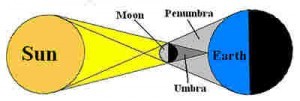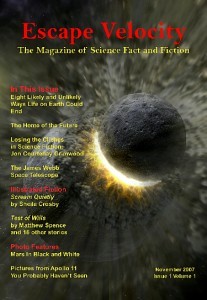#Coincidences and the #Moon
 Well that’s odd. I wrote a blog piece this morning on Inside the Mind of Geoff, pressed the Publish button and away it went. I know it succeeded because when published a link is sent to my twitter feed. Many Retweets have happened since but they all point at a blog piece that’s years old! Hopefully this one is more successful.
Well that’s odd. I wrote a blog piece this morning on Inside the Mind of Geoff, pressed the Publish button and away it went. I know it succeeded because when published a link is sent to my twitter feed. Many Retweets have happened since but they all point at a blog piece that’s years old! Hopefully this one is more successful.
Rather than spend a couple of hours writing a new piece I offer here a blog article I wrote for Escape Velocity magazine related to the Moon – topical with the recent total eclipse.
It annoyed me a little that the otherwise excellent BBC coverage of the 2015 total eclipse dumbed down the vocabulary for the viewer. This is demeaning because all 13-year-olds in the UK have to know about eclipses in terms of umbra, penumbra and need to use words like reflection for their exams. They won’t get marks for bounce when the proper term is reflection.
Illusions, Coincidences and the Moon
Compiled by Geoff Nelder
Based on an article in Escape Velocity Issue #3 by Geoff Nelder
More than one?
Which moon I hear you ask. I could have filled a page or so about Cruithne, the 3-mile-wide (5-km) satellite, which takes 770 years to complete a horseshoe-shaped orbit around Earth. Some say it isn’t a proper moon, but let’s not go there. It will be up yet not easily visible around Earth for at least 5,000 years. I’ll focus this article on the moon we can see.
Dumbbell
I used to tease my students by saying that the Earth goes around the Moon. To my dismay, I often found no reaction until I repeated it louder, and then they’d assumed I’d made a mistake. However, they accept the elliptical nature of the Moon’s orbit and when they were told that the focus is not in the dead centre of Earth but about 1700km beneath its surface, the unequal dumbbell dual orbit is appreciated.
A few facts
I could pack this piece with dry facts such that the Moon is a quarter the diameter of Earth and 1/81 its mass. The average centre-to-centre distance from the Earth to the Moon is 384,403 km, which is about thirty times the diameter of the Earth. The Moon has a diameter of 3,474 km…. STOP! Anyone can scroll through data, let’s go for interesting.
Now you see it…
Unlike ancient Man we now take eclipses for granted. Tabloid newspapers, not a wise old shaman, alert us these days. But would anyone have bothered were it not for the coincidence that the moon was orbiting just at the right distance for its disc to perfectly cover the Sun? Not that it always did so. The Moon used to be much closer, and so looked larger. It’s drifting away at a rate of around 4 cm per year. However, by the time Man kept records and made predictions, the eclipses were perfect. Why? The Sun’s diameter is 375 times that of the Moon. The Sun is 375 times the distance. Hence both have an angular diameter of around ½ degree as seen from your house. However, the gravitational tug is slowing the Earth’s spin. By the conservation of momentum and the Moon’s initial impetus, the Moon’s distance from Earth is increasing. Eventually, the Moon will not seem to cover the Sun giving us only annular eclipses. One day the Moon will stop drifting away – and return – whack. Or it will disintegrate at the Roche Limit, either way humans had better find somewhere else to live. On the other hand the Moon won’t reach us for another 50 billion years and we would have been engulfed by our sun doing its red giant trick long before that – maybe in 5 billion years. No sweat.
Optical illusion or mental delusion
Many people think the moon looks large at the horizon in contrast to its overhead (zenith) position. This is an illusion and in spite of overhearing people mentioning the magnifying lens of the atmosphere, the apparent size of the moon hardly changes. A simple proof would be to hold a small coin (you’d be surprised how small) to just cover the moon at zenith and again on the horizon. This is probably more a perception than an optical problem. Even back in 200 AD, Cleomedes suggested that the horizon moon looks larger because it is farther away, and our minds thus trick us. This was perceptive of him since, of course, the moon is about an Earth’s radius farther away when we view it on the horizon! Washburn in 1894 suggested that if we look at the horizon moon from between our legs (ie upside down) then the illusion vanishes. Perhaps we could do a straw poll on that one!
Part of the illusion maybe because the moon appears squashed and more red at the horizon – not a lens but a prism effect. Certainly, the scattering of the shorter wavelength blue light through the atmosphere allowing only the near-red longer wavelengths through gives us orange and red moons as it does for the sun.
Impact
There are half a million impact craters on the moon, mostly on the side facing away from the Earth for obvious reasons. What the nearside does have are Maria, which are large solidified seas of lava. These are likely to be the results of collisions with meteors or comets, but why should the nearside have them in preference to the farside? One theory is that the side of the Moon facing the Earth has a higher concentration of heat-producing elements (Shearer, 2006). This is supported by geochemical mapping via the satellite Lunar Prospector.
Origin
Hartmann & Davis in 1975 produced the most acceptable hypothesis that the Moon is the result of a giant impact from a Mars-sized planet colliding with Earth around 4.5 billion years ago. By then much of the iron on our planet had accumulated into the core, but only lighter mantle rock was blasted off and after forming a ring then aggregated into a sphere but with little iron. Unlike the other solar system objects the moon shares similar oxygen isotopes to that found in the Earth. So it is unlikely the Moon is a captured planetoid nor did it form by spinning off an early Earth or it would have more iron and computer models don’t support the dynamics.
Now we know the moon has significant quantities of water, it will be shortly be occupied even if only by researchers. Water is handy stuff and not just for drinking and washing. We only know there’s a few water tanks full in one crater for sure. Maybe water was donated by crashed comets or from ancient volcanoes – whichever, a lot more surveying is needed. They’ll be able to split the molecules to extract oxygen and hydrogen.
Would minds on Earth have had their imagination stretched more if we’d had a ring orbiting us instead of a moon? If so, would we all have been more intelligent and creative now? Intriguing isn’t it?
References
Hartmann, W. K. and D. R. Davis 1975 Icarus, 24, 505
Shearer, C.; et al. (2006). “Thermal and magmatic evolution of the Moon”. Reviews in Mineralogy and Geochemistry 60: 365–518
Most of this article came from Escape Velocity issue 3 published by Adventure Books of Seattle. To grab your own copy of the magazine to read the rest of the marvelous stories and articles go to
http://www.adventurebooksofseattle.com/titlesforkindlereader.htm
Nelder News
The ARIA giveaway at Goodreads for April has finished and the lucky winner has been sent a signed copy of ARIA: Left Luggage for him to read in his native Canada and hopefully to write a favourable review.
If you want to get your hands on a copy – in print or ebook then please go to my website
and follow the links.
The post #Coincidences and the #Moon appeared first on Geoff Nelder - Science Fiction Writer.





